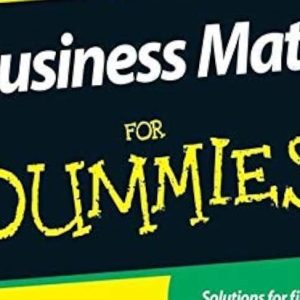
Business Math Formulas (Speedy Study Guides) is your go-to quick reference for mastering essential business calculations.
Business Math Formulas (Speedy Study Guides): A Compact Companion for Quick, Accurate Decision-Making
In the dynamic world of business, numbers rule. Whether you’re calculating interest, analyzing profit margins, pricing products, managing payroll, or projecting revenue, business math is the bedrock of strategic decision-making. And when time is limited, accuracy is critical, and simplicity is valued, a Speedy Study Guide becomes a powerful tool.
Business Math Formulas (Speedy Study Guides) is designed for those who need fast access to the core formulas that drive financial and operational success. Packed with the most frequently used equations across business disciplines—finance, accounting, economics, statistics, and marketing—this guide serves students, small business owners, analysts, and executives alike.
Why Business Math Matters
In business, even small errors in calculation can lead to significant losses. Understanding and applying the right formula at the right time ensures:
- Profitable pricing
- Accurate forecasting
- Effective budgeting
- Informed investment decisions
- Legal compliance in payroll and tax
- Data-driven marketing insights
This guide makes it possible to quickly find, understand, and use essential formulas without flipping through dense textbooks or digging through search engines.
Who This Guide Is For
- High school and college students taking business math, accounting, finance, or economics courses
- Entrepreneurs and small business owners who manage operations, pricing, payroll, or inventory themselves
- Corporate professionals who work in accounting, finance, or business analysis
- MBA students preparing for exams or managing case studies
- Job seekers wanting to sharpen their practical math skills for interviews or assessments
This isn’t a comprehensive textbook—it’s a focused tool for practical use, perfect for daily reference or exam revision.
What You’ll Find Inside
This Speedy Study Guide is organized by key business disciplines. Each section contains the most-used formulas, explanations of variables, example problems, and shortcuts to boost speed and comprehension.
📈 1. Finance Formulas
Finance deals with the management of money, assets, investments, and credit. You’ll find formulas such as:
- Simple Interest (SI)
SI=P×R×TSI = P \times R \times TSI=P×R×T
Where:
P = Principal, R = Interest Rate, T = Time - Compound Interest (CI)
CI=P(1+rn)nt−PCI = P(1 + \frac{r}{n})^{nt} – PCI=P(1+nr)nt−P - Present Value (PV)
PV=FV(1+r)nPV = \frac{FV}{(1 + r)^n}PV=(1+r)nFV - Future Value (FV)
FV=PV×(1+r)nFV = PV \times (1 + r)^nFV=PV×(1+r)n - Net Present Value (NPV)
NPV=∑Rt(1+r)t−C0NPV = \sum \frac{R_t}{(1 + r)^t} – C_0NPV=∑(1+r)tRt−C0 - Internal Rate of Return (IRR)
(Determined using NPV set to zero)
These formulas help evaluate investments, savings, and returns—critical for both business planning and personal financial literacy.
📊 2. Accounting Formulas
Accounting formulas are the backbone of financial statements and audits. Common formulas include:
- Accounting Equation
Assets=Liabilities+EquityAssets = Liabilities + EquityAssets=Liabilities+Equity - Net Income
NetIncome=Revenue−ExpensesNet Income = Revenue – ExpensesNetIncome=Revenue−Expenses - Gross Profit Margin
Gross Margin=Revenue−COGSRevenue×100\text{Gross Margin} = \frac{\text{Revenue} – \text{COGS}}{\text{Revenue}} \times 100Gross Margin=RevenueRevenue−COGS×100 - Break-even Point
Break-even=Fixed CostsSelling Price−Variable Costs\text{Break-even} = \frac{\text{Fixed Costs}}{\text{Selling Price} – \text{Variable Costs}}Break-even=Selling Price−Variable CostsFixed Costs - Return on Assets (ROA)
ROA=Net IncomeTotal AssetsROA = \frac{\text{Net Income}}{\text{Total Assets}}ROA=Total AssetsNet Income - Return on Equity (ROE)
ROE=Net IncomeShareholder’s EquityROE = \frac{\text{Net Income}}{\text{Shareholder’s Equity}}ROE=Shareholder’s EquityNet Income
These formulas help assess a company’s financial health and operational performance.
📉 3. Economics Formulas
Economics deals with scarcity, choice, and the allocation of resources. In this section, you’ll find:
- Price Elasticity of Demand (PED)
PED=% Change in Quantity Demanded% Change in PricePED = \frac{\%\ \text{Change in Quantity Demanded}}{\%\ \text{Change in Price}}PED=% Change in Price% Change in Quantity Demanded - Total Revenue (TR)
TR=Price×QuantityTR = Price \times QuantityTR=Price×Quantity - Average Cost (AC)
AC=Total CostQuantityAC = \frac{\text{Total Cost}}{\text{Quantity}}AC=QuantityTotal Cost - Marginal Cost (MC)
MC=ΔTotal CostΔOutputMC = \frac{\Delta \text{Total Cost}}{\Delta \text{Output}}MC=ΔOutputΔTotal Cost - GDP (Expenditure Approach)
GDP=C+I+G+(X−M)GDP = C + I + G + (X – M)GDP=C+I+G+(X−M)
These formulas provide insight into market behavior, production efficiency, and economic performance.
📦 4. Business Operations & Inventory
Efficient operations require careful management of resources, time, and inventory. Useful formulas include:
- Inventory Turnover
Inventory Turnover=COGSAverage Inventory\text{Inventory Turnover} = \frac{\text{COGS}}{\text{Average Inventory}}Inventory Turnover=Average InventoryCOGS - Reorder Point
Reorder Point=Lead Time×Daily Usage\text{Reorder Point} = \text{Lead Time} \times \text{Daily Usage}Reorder Point=Lead Time×Daily Usage - Economic Order Quantity (EOQ)
EOQ=2DSHEOQ = \sqrt{\frac{2DS}{H}}EOQ=H2DS
Where: D = Demand, S = Setup cost, H = Holding cost
These help in controlling inventory levels and ensuring smooth business operations.
💵 5. Payroll and Tax
Mistakes in payroll and tax can be costly. Here are formulas to stay accurate:
- Gross Pay
Gross Pay=Hours Worked×Hourly Rate\text{Gross Pay} = \text{Hours Worked} \times \text{Hourly Rate}Gross Pay=Hours Worked×Hourly Rate - Net Pay
Net Pay=Gross Pay−Deductions\text{Net Pay} = \text{Gross Pay} – \text{Deductions}Net Pay=Gross Pay−Deductions - Taxable Income
Taxable Income=Gross Income−Allowances and Deductions\text{Taxable Income} = \text{Gross Income} – \text{Allowances and Deductions}Taxable Income=Gross Income−Allowances and Deductions - Sales Tax
Sales Tax=Price×Tax Rate\text{Sales Tax} = \text{Price} \times \text{Tax Rate}Sales Tax=Price×Tax Rate
This section aids HR professionals, freelancers, and business owners.
📈 6. Marketing & Pricing
Marketing decisions often rely on data and ROI calculations. Included formulas are:
- Markup
Markup=Selling Price−Cost PriceCost Price×100\text{Markup} = \frac{\text{Selling Price} – \text{Cost Price}}{\text{Cost Price}} \times 100Markup=Cost PriceSelling Price−Cost Price×100 - Margin
Margin=Selling Price−CostSelling Price×100\text{Margin} = \frac{\text{Selling Price} – \text{Cost}}{\text{Selling Price}} \times 100Margin=Selling PriceSelling Price−Cost×100 - Customer Acquisition Cost (CAC)
CAC=Marketing ExpensesNew Customers AcquiredCAC = \frac{\text{Marketing Expenses}}{\text{New Customers Acquired}}CAC=New Customers AcquiredMarketing Expenses - Return on Marketing Investment (ROMI)
ROMI=Revenue from Campaign−Marketing CostMarketing Cost×100ROMI = \frac{\text{Revenue from Campaign} – \text{Marketing Cost}}{\text{Marketing Cost}} \times 100ROMI=Marketing CostRevenue from Campaign−Marketing Cost×100
These calculations support smarter pricing, customer targeting, and campaign measurement.
📐 7. Business Statistics
Business statistics support analysis and forecasting. Included formulas:
- Mean (Average)
xˉ=∑xn\bar{x} = \frac{\sum x}{n}xˉ=n∑x - Median
(Middle value in ordered data set) - Standard Deviation (σ)
σ=∑(x−xˉ)2n\sigma = \sqrt{\frac{\sum (x – \bar{x})^2}{n}}σ=n∑(x−xˉ)2 - Probability (P)
P(E)=Number of Favorable OutcomesTotal OutcomesP(E) = \frac{\text{Number of Favorable Outcomes}}{\text{Total Outcomes}}P(E)=Total OutcomesNumber of Favorable Outcomes - Z-score
Z=X−μσZ = \frac{X – \mu}{\sigma}Z=σX−μ
Statistical understanding allows better forecasting, quality control, and business insight.
Why Use a Speedy Study Guide?
This guide isn’t just for test preparation—it’s designed to:
- Save time with quick access to verified formulas
- Reinforce memory through repetition and visual structure
- Support practical applications in real-world business scenarios
- Eliminate overwhelm by simplifying key concepts
- Encourage independent problem-solving with examples and explanations
Because of its portable and concise format, this Speedy Study Guide is perfect for exam cramming, boardroom meetings, or daily decision-making.
Tips for Getting the Most Out of This Guide
- Use tabs or highlights to mark frequently used sections
- Combine with practice problems to reinforce formula usage
- Translate formulas into real-life cases for better understanding
- Memorize core formulas, but keep the guide as backup
- Review before meetings, exams, or financial planning sessions







